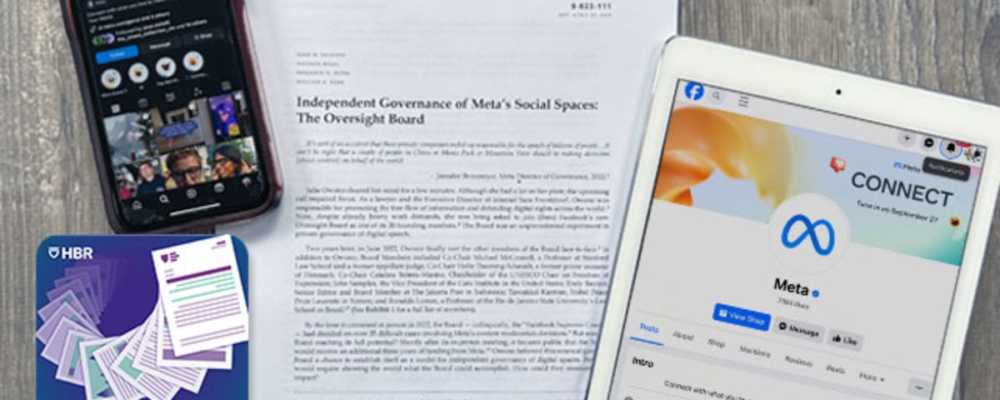Is it possible to truly empower employees to make their own decisions—even when those decisions could mean life or death?
That is the question posed by the Dutch home healthcare organization Buurtzorg, which has radically avoided almost all middle management, allowing its nurse teams to care for their patients as they see fit.
A new Harvard Business School case study explores Buurtzorg’s decentralized model in depth, with lessons for institutions struggling with morale and productivity. Buurtzorg’s approach has yielded patient satisfaction ratings that are 30 percent higher than those of comparable organizations, with absenteeism, turnover, and overhead up to two-thirds lower.
“We know that workplace disengagement is a big problem these days. We also know from research that when employees feel empowered, they report being more motivated at work.”
“We know that workplace disengagement is a big problem these days. We also know from research that when employees feel empowered, they report being more motivated at work,” says Tatiana Sandino, the Arthur Lowes Dickinson Professor of Business Administration at HBS and one of the case’s authors. “During our interviews and research for this case, we heard anecdotes from Buurtzorg’s employees that suggest many, if not most, of them are highly engaged, take full ownership of their work, are pursuing creative ways of serving their patients, and feel motivated to do the best work they can.”
Among other things, Buurtzorg offers a compelling example for companies struggling to re-engage “quiet quitters” while balancing rising costs and mixed economic signals. The company began in the Netherlands in 2006 as an antidote to what the founders viewed as innovation-crushing managed care. Now, more than 10,000 nurses provide care unencumbered by management layers, making independent decisions about everything from where to buy bandages to how to discipline a nurse who slacks off.
“Working in an organization that trusts you and cares for you makes things possible you had not thought about before,” one nurse says in the case. “The creativity was just out of the box. You can get so much out of a person, they bring so much to the table, and it is so innovative to work this way. I wish lots of other people had that, too.”
Maybe they can. Ethan Bernstein, the Edward W. Conard Associate Professor of Business Administration at HBS and co-author of the case, asks his students whether other companies could export Buurtzorg’s lessons to their industries. “In our case discussions, the students—whether MBAs or executives—don’t write-off Buurtzorg as an extreme case, or unique,” he says. “Instead, they ask, ‘How do we do this when we get back to our organizations?’ And as companies face employee reductions in this economic climate, perhaps they should consider doing so in a way that removes layers of organizational structure as well.”
How Buurtzorg works
Jos de Blok, one of Buurtzorg’s founders, envisioned a system of self-managed care teams after experiencing firsthand as a nurse, and then a decade as a senior leader of two large healthcare organizations, how the healthcare system managed quality and productivity in ways that required counterproductive layers of management. “No one could really do what they thought was necessary, and patient care suffered as a result,” he says in the case.
Together with co-founders Gonnie Kronenberg and Ard Leferink, de Blok built a system of neighbourhood-based teams of no more than 12 nurses. If a team grows larger than 12, it splits into two teams; teams that fall below six nurses merge. Nurses make up 99.5 percent of Buurtzorg’s workforce.
“Buurtzorg seems to capture the power that is unleashed when people can make their own decisions.”
Each nursing team manages itself. To ensure financial sustainability, Buurtzorg nurse teams must spend at least 62 percent of their time on billable patient care. But beyond that, there are few rules. As a unit, they decide which new patients to accept, how to handle problems, and how to run their offices. Each team has several administrative roles, including housekeeper, reporter, vitality manager, team player, planner, and mentor. However, even though nurses rotate through administrative roles, every nurse’s primary job remains patient care.
Typically, three to four nurses on a team care for one patient, allowing for consistency and closer patient relationships, while also ensuring round-the-clock coverage. They can decide what the patient most urgently needs, buy medical supplies, and adjust care plans without having to go through levels of clearance. Buurtzorg means “neighbourhood nursing” in Dutch, and nurses ensure care for patients from doctors, family, friends, and neighbours.
“Buurtzorg seems to capture the power that is unleashed when people can make their own decisions,” Sandino says.
Sometimes these decisions can push boundaries. The case describes nurses backdating a family meeting to the day of a patient’s death so that they don’t have to interrupt the family’s grieving with end-of-care meetings. But the level of trust is so high at Buurtzorg that such decisions don’t ruffle feathers, and one of de Blok’s key responsibilities is to ensure stakeholders learn from, rather than punish, the nurses’ productive deviance. “Nothing was a surprise, everything was discussed in the open, and nobody was worried about anything, even if it could be controversial,” Sandino says.
How to think like a self-managed team
Sandino and Bernstein, who study structured empowerment and self-managed teams, respectively, say three factors make the loosely-centralized model work:
Highly qualified employees. Buurtzorg hires nurses with a certification above the requirement and pays them one salary level beyond that. In the midst of a perennial talent shortage in nursing, this allows Buurtzorg to retain experienced nurses, and attract high-quality new nurses, effectively.
A not-for-profit, Buurtzorg also reserves two percent of revenue for unforeseen costs; if that money isn’t used, a portion goes toward bonuses for nurses, meaning that they share ownership over the residual benefits of their out-of-the-box work.
It all adds up to higher morale and productivity. The workplace culture is described as “almost euphoric,” and de Blok explains that, “if a team feels ownership over their decisions, they happen faster.”
Emphasis on accountability. Could Buurtzorg offer too much freedom, and endanger patient lives or lead to misconduct? The organization has implemented important mechanisms to address these risks, say the authors.
“The company does have some important implicit boundaries—things that are simply not acceptable. For example, if a nurse deliberately did something that was not in a patient’s best interest, they wouldn’t ignore it,” Sandino notes.
If a nurse team struggles with a particular problem and feels unable to resolve it without help, the team can reach out to one of its 20 coaches, whose role is to support teams without stepping in to directly manage their problems. To preserve autonomy, nurses are free to reject the advice of coaches, or not to consult them at all, but in practice, most nursing teams find the coaching supportive of their aspirations to do better. Bernstein points out, “as opposed to other organizations, where coaches often report back to management, here the coaches are solely focused on helping nurses.”
Strong IT systems for communication. Teams use an IT system called BuurtzorgWeb, through which they share patient notes, distribute knowledge, collaborate on problems that extend beyond a single neighbourhood team, and access the Omaha System, a standardized taxonomy to classify patient care and outcomes. Complemented by more informal forms of communication, BuurtzorgWeb allows everyone to help each other in real time and capture knowledge as it emerges.
Two considerations about decentralization
But getting the free-spirited model right is not without challenges.
Adapting to external crises, such as the COVID-19 pandemic and the severe nursing shortage, can be difficult in a decentralized organization. When the business environment shifts, traditional organizations use their management layers to provide enterprise-wide direction. This is something Buurtzorg cannot easily do.
Indeed, recent research by Bernstein and co-authors demonstrates that centralization can improve complex problem-solving in a shifting environment because it helps preserve the diversity of ideas and enables a core to elevate the best ones, as long as two-way communication exists. One way to preserve that communication, Sandino’s research suggests, could be through the higher levels of employee autonomy that “structured empowerment” promotes—presenting the best ideas to employees as choices rather than mandates, while holding them accountable for results.
The COVID-19 pandemic forced Buurtzorg to wrestle with whether and how it could achieve the communication benefits of centralization without the costs of bureaucracy and hierarchy. For organizations inside or outside of health care, the case study invites some critical questions:
What function should the back office and middle management serve? The answer will vary at every company. Buurtzorg has been very careful about the “dos” and “don’ts” of the back office’s responsibilities. When in doubt, they default to “don’t.” This approach is taken to prevent them from inadvertently or implicitly undermining the organization’s decentralized model and nurses’ sense of autonomy.
Buurtzorg’s 50-person back office performs a few time-consuming functions, such as billing, lease contracting, and IT. They see their role as serving the nurse teams, not overseeing them. Anyone who mistakenly refers to the back office as “headquarters” will quickly be corrected.
“There is someone in the middle who can see all the ideas, bring them together, and send out the best ones, while still trying to ensure that there is no layer of management to take control away from the nurses,” Bernstein says.
Technology (BuurtzorgWeb) serves as the main way nurses communicate and share best practices—functions typically performed by middle managers.
What about efficiency? As the nursing shortage is predicted to become more severe, all health organizations, including Buurtzorg, will be under pressure to become more efficient with nursing time. A traditional approach to efficiency involves management-led initiatives for operational improvement—and yet, over the past two decades, Buurtzorg has improved faster and more effectively with their alternative decentralized model.
“There is a structure behind it, accountability within teams, and a lot of feedback and support that lets employees do well.”
Will that continue? It can be tantalizing to consider non-nurse hierarchical layers to relieve nurses of some of their non-patient work and increase utilization from 62 per cent to something much higher. That could also ensure that geographically dispersed employees do not reinvent the wheel when solving problems.
The organization has been experimenting with methods to foster idea development and has implemented a de facto structured empowerment model, where best practices are shared without being imposed. And that’s the question that continues to animate leaders as they try to find the sweet spot between too much and too little autonomy.
“It’s not anarchy,” Sandino says. “There is a structure behind it, accountability within teams, and a lot of feedback and support that lets employees do well.”
Annelena Lobb is a senior case researcher and also one of the coauthors of “Buurtzorg.”
“Harvard Business School is the graduate business school of Harvard University, a private research university in Boston, Massachusetts. It is consistently ranked among the top business schools in the world and offers a large full-time MBA program, management-related doctoral programs, and executive education programs.”
Please visit the firm link to site





